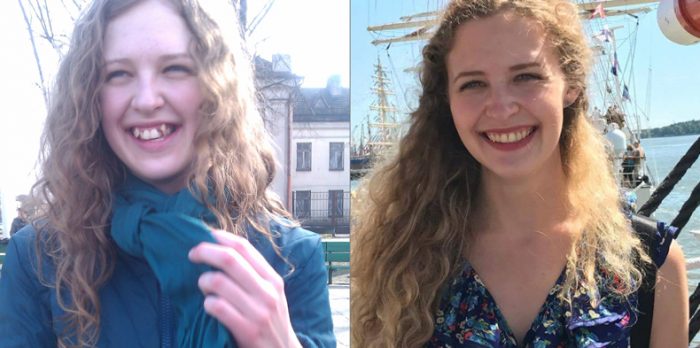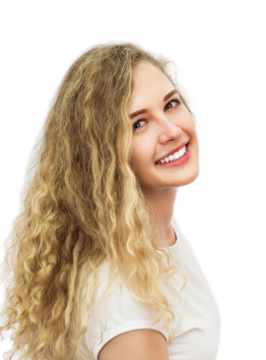Yes, perhaps this treatment looks tough and frightening. It’s only natural, but it will only seem so at the very beginning. Later, you’ll get into that treatment process, and ultimately, you’ll have that healthy and beautiful smile.
Domante, what was your life like before the surgery? What troubles did you experience due to malocclusion and incorrect position of jaws?
Before the start of the treatment, I didn’t think about that, whether my occlusion is correct or not – I just chewed the food in any way I could. I was lucky that the pathology of my jaw (maxilla was too narrow and too small) didn’t cause any noticeable facial distortion. Due to maxilla pathology, my both incisors were higher than other teeth, and they didn’t fit. To the people around me, such an aesthetic caused no problems because one gets accustomed to the view, and it becomes usual, but when meeting the new people… my teeth would attract attention. When I spoke or laughed, I noticed that they’re looking at my teeth; all that view would distract the companion and embarrass me. While at school, I had various teeth-related remarks thrown at me.
Where from did you learn about such treatment methods, and what encouraged you to choose it?
My mom was making inquiries on how to correct the malocclusion until one small town odontologist told her that the extraction of incisors would solve the problem. Mom didn’t agree with such a solution to a problem and turned to other specialists. One odontologist proposed to wear an orthodontic trainer, but once it proved itself useless, wearing a plate was advised. While wearing a plate, one side of the jaw began expanding, and once the incisor started descending, but the other side of the jaw remained the same. Then the doctor proposed to wait until 18 years of age and then seek surgical treatment. So, I grew 18 years old, graduated from school, and entered the university in Kaunas, turned to orthodontist Dalia Latkauskienė. I learned about her on the internet and from the recommendations of my acquaintances. After assessing my occlusion, she referred me for a visit to doctor Simonas Grybauskas. During the visit, I got familiarized with the preliminary treatment plan, one awaiting surgery, and if need be, a second surgery, and treatment duration. As I left the doctor’s office and walked down the Laisvės alėja (Liberty Boulevard in Kaunas), I couldn’t stop tears from running down my cheeks. I got scared! Scared of all those surgeries, those long years of treatment, I didn’t know whether I’ll be able to combine my studies that just begun with the treatment… but my mom walked by my side and calmed me down, assured me that everything’s going to be alright. In this way began my five-year journey to a beautiful smile.
Before choosing orthognathic treatment, have you made inquiries about the experiences, opinions of others? What was the reaction like of those around you when they found out that you have decided to have surgery?
Many people around me were saying, “why would you need that surgery, why would you need such a difficult and long-term treatment, get those incisors extracted, many guys did that already… you’ll save both money and time,” or something like “you won’t be able to study and get treatment at the same time, you won’t be able to complete the studies because of those teeth.” I tried to explain to such people that this treatment is necessary for my health, for correct occlusion. I was telling them that the extraction of teeth is not a proper solution, that it would eliminate the problem only on the visual level. Still, the incorrect wearing of dental surfaces would remain, which, due to improper chewing of the food, could lead to future problems of joints in the jaw.
How did the treatment process go? What moments were the hardest? Most comforting?
Many visits were required throughout the entire treatment process both to Simonas Grybauskas and to Dalia Latkauskienė. Now, when these visits are over, I even begin to miss them. It’s strange that I no longer have to visit them so frequently, it has become a habit already. After my first surgery (bone ridge splitting in the maxilla), I recovered quickly, the feeding – liquid diet was my only tribulation. Even now, I recall it with a smile on my face, when on my friend’s birthday, I blended a steak with potatoes in a blender, and it tasted like pâté. During the second surgery, more things get done than during the first, so the entire healing process was more complex and took longer. The first two weeks after the surgery were complicated both physically and emotionally (pain, discomfort while sleeping because of a face mask, swelling of a face, people’s reaction to it). I wished to get back to the old life that I had before the surgery. I eagerly anticipated for the swelling to subside and my face to be as before, but once the swelling subsided, I looked in the mirror, and my face looked different. I seemed I’m looking at myself, but there’s different me, no the previous one. It took me about three days until it no longer felt weird looking at myself in the mirror.
In your opinion, what is critically important when deciding and choosing orthognathic treatment? What would you advise other people to encounter a similar situation?
To people who are yet only considering whether they need to have such kind of treatment, I’d recommend getting rid of all doubt and take a step to eliminate defects that impede and limit your life. Yes, perhaps this treatment looks tough and frightening. It’s only natural, but it will only seem so at the very beginning. Later, you’ll get into that treatment process, and ultimately, you’ll have that healthy and beautiful smile, or even a slightly transformed face, as it happened in my case. All this is done to get into a new stage of life. Before making up your mind and choosing orthognathic treatment, it is essential to be in a disposition to change, to come to terms with possible changes, and do not be afraid of them. Of course, a clear realization that it will cost a lot of time and patience is also essential. Also, it is a substantial financial investment in oneself and one’s health. I’m happy that treatment didn’t hinder my studies, and soon I’ll graduate from the studies that lasted a little longer than my treatment.
How did your life change after the treatment (both from the personal and professional side)?
Once the entire treatment period was over, I felt terrific. I keep smiling, I’m delighted, my self-confidence increased by 110%, I gladly communicate with new people, and it’s essential both in my new job after the graduation, and in my further life.
If you could turn back time, already knowing and experiencing as much as you have now, would you still choose to have orthognathic treatment?
If I could turn back time, knowing all this, what I’ve experienced after I chose to have orthognathic treatment, I’d choose repeating it all over again without a doubt. It’s an exciting life experience with a great outcome. Once more I’d like to thank doctor Simonas Grybauskas and his entire wonderful team for granting me a possibility to eliminate defects, and a chance to live without limitations. As my mom once said: “Simonas Grybauskas is like an artist, a sculptor who not only treats but also creates beautiful faces for the people and thus makes this world not only healthier but also happier place.”
—
Orthognathic treatment always includes the joint work of doctor orthodontist and surgeon’s team. The team of Dr. Simonas Grybauskas would like to express gratitude to orthodontist doctor Dalia Latkauskienė for collaboration. Such treatment results were accomplished by courtesy of her.






